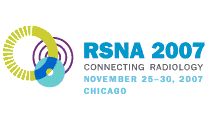
Abstract Archives of the RSNA, 2007
Caleb Roberts BSc, Presenter: Nothing to Disclose
Vivian E. Rushton, Abstract Co-Author: Nothing to Disclose
Geoff James Parker PhD, Abstract Co-Author: Nothing to Disclose
Chris J. Rose PhD, Abstract Co-Author: Research funded, GlaxoSmithKline plc
James P. O'Connor MA, Abstract Co-Author: Research funded, CRUK
Alan Jackson MD, PhD, Abstract Co-Author: Nothing to Disclose
Yvonne Watson, Abstract Co-Author: Nothing to Disclose
Stavros M. Stivaros FRCR, Abstract Co-Author: Nothing to Disclose
et al, Abstract Co-Author: Nothing to Disclose
et al, Abstract Co-Author: Nothing to Disclose
To evaluate parotid gland microvascular characteristics in Sjögren’s Syndrome (SS) using dynamic contrast-enhanced magnetic resonance imaging (DCE-MRI). To test whether DCE-MRI can discriminate between SS patients and healthy volunteers (HV).
21 patients with histologically confirmed SS and 11 HV had a single 3D T1-weighted DCE-MRI scan of the parotid gland at 1.5T. A tracer kinetic model provided voxel-wise estimates of the vascular plasma volume (vp), the extracellular-extravascular volume (ve) and the volume transfer constant (Ktrans). The initial area under the gadolinium concentration-time curve (IAUC) and the T1-weighted signal intensity were also obtained for each voxel. A region of interest was drawn to include the entire gland. Median values and standard deviation were obtained for each of the tracer kinetic parameters, IAUC and the signal intensity. Differences between SS and HV were investigated using Mann-Whitney U tests, a multivariate analysis of variance (MANOVA) and receiver operator characteristic (ROC) analysis.
MANOVA revealed significant overall difference between the median parameter values for the two groups (p < 0.001). All median parameters were elevated in SS patients versus HV (Ktrans p = 0.017, ve p = 0.001 and IAUC p = 0.012. vp differences were not statistically significant). ROC curves indicated that 70% of SS patients can be correctly identified with no false positives; 100% sensitivity was achieved at a specificity of 64%. Group median standard deviation for each parameter was elevated in SS compared with HV (p < 0.001 for each parameter). ROC analysis showed that perfect group discrimination could be achieved from the parameter standard deviation data.
Signal intensity, IAUC and tracer kinetic model-derived DCE-MRI parameters all provide useful information regarding microvascular pathophysiology and heterogeneity of the parotid gland in SS. In particular, parameters such as Ktrans, ve and vp provide specific physiological information regarding the nature of microvascular alterations in SS.
DCE-MRI biomarkers have potential utility in diagnosis, disease management and evaluation of therapy in Sjögren’s Syndrome.
Roberts, C,
Rushton, V,
Parker, G,
Rose, C,
O'Connor, J,
Jackson, A,
Watson, Y,
Stivaros, S,
et al, ,
et al, ,
Quantifying Parotid Gland Function in Sjögren’s Syndrome in Patients and Healthy Volunteers Using Dynamic Contrast-enhanced MRI and Tracer Kinetic Modeling. Radiological Society of North America 2007 Scientific Assembly and Annual Meeting, November 25 - November 30, 2007 ,Chicago IL.
http://archive.rsna.org/2007/5000739.html

